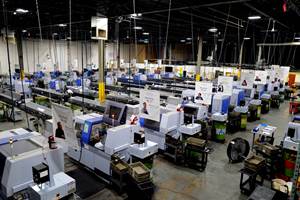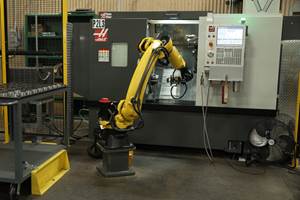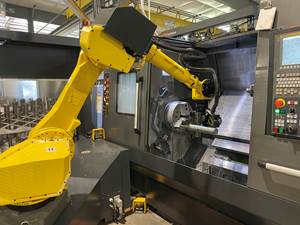CAM Software Standardizes, Automates Programming
By encapsulating repetitive procedures and best practices into easy-to-execute routines, CAM software has enabled this shop’s employees to stay focused on value-added tasks, facilitated its efforts to automate production, and contributed to improved productivity and profit margins.
Share





Deep recessions have a way of forever transforming the business landscape, and companies that survive often emerge far different than they once were. One example is Decimal Engineering, a shop that entered the downturn as a contract manufacturer and emerged as a provider of custom parts and engineering services. The company cites Edgecam software from Planit Solutions (Forest Lake, Minnesota) as a key part of the investment that made this transition possible. By encapsulating repetitive procedures and best practices into easy-to-execute routines, the software has enabled employees to stay focused on value-added tasks, facilitated the shop’s efforts to automate production, and contributed to improved productivity and profit margins.
Decimal Engineering is a full-service precision sheet metal fabricator and machine shop specializing in the electronics, telecommunications, medical, computer, automotive and marine industries. Managed by brothers Alan, Mark and Kevin Garey, the second-generation family business employs 85 people and occupies a 40,000-square-foot facility in Pompano Beach, Florida. Since the Garey family purchased the company in 1980, its steady growth has required periodic facility expansions and investments in new equipment.
Morphing from job shop to custom manufacturer, however, proved to be the largest undertaking in the shop’s history. In fact, capital investments for 2008 and 2009 totaled $1.8 million. While a significant portion of those funds went toward an automated laser cutter and other new fabricating equipment, the transition started with the machining side of the business. Older CNC machines have been retired in favor of such equipment as a nine-axis turning center from Mori Seiki (Hoffman Estates, Illinois) and two automated, pallet-changing H400 HMCs from Kitamura (Wheeling, Illinois).
As a result, what began as a tool room to support the sheet metal fabricating operation now accounts for a full third of the company’s revenue. Flexible manufacturing systems like the Kitamuras enable lights-out production overnight and on weekends. This holds down costs on both larger-volume part runs and short-run jobs programmed to run sequentially. The shop can also achieve tighter tolerances and more easily meet just-in-time (JIT) delivery targets, among other gains. The bottom line is that the company’s investments have enabled it to take on more complex work from more demanding customers with deeper pockets, says Alan Garey, Decimal’s president.
Of course, getting the new equipment to meet its full production potential required the shop to abandon its long reliance on 2 1/2-D CAM, so it upgraded to the multi-axis Edgecam Pro system. However, the Garey brothers emphasize that the software’s benefits go beyond simply providing the capability to program the shop’s new machines. It has essentially taken over many of the repetitive, tedious tasks that previously required significant investments of time and knowledge from the shop’s most valuable resource—its people. As a result, employees can concentrate on bolstering customer relationships, outperforming competitors and winning new business.
These benefits begin up-front, where the software saves time for the seven full-time engineers the company now em-ploys to review, design or redesign customer jobs. As part of its transition to providing product development and engineering, the shop has moved to full 3D CAD design and solid modeling by bringing in SolidWorks design software from Dassualt Systèmes and upgrading its Autodesk Mech-anical Desktop and AutoCAD systems to Autodesk Inventor. This has improved the shop’s ability to ensure that parts work for the customer up-front, before even a prototype is produced. However, engineering revisions and translation problems would be a significant burden on programmers if the new design systems couldn’t effectively integrate with the company’s CAM package.
Enter Edgecam’s Solid Machinist module, which provides tight associativity with both of these programs. Mark Garey, engineering manager, says Solid Machinist ensures that no data is lost in translation when importing or revising part designs, regardless of the originating system. Additionally, it allows reloading part revisions, which provides a handy way to accommodate engineering changes between repeat jobs—or even within a job—without having to modify the underlying part program. “If we change a part model in Inventor or SolidWorks, the programmer is automatically notified and can download the latest revisions,” he notes.
Beyond the engineering stage, Edgecam enables the shop to simultaneously standardize and automate part programming. This is done in large part through the software’s Strategy Manager, a visual, flow-chart-oriented approach to manage the programming of repetitive machining operations. Essentially, the Strategy Manager enables the shop to program the programming of its machines, says Larry Rhodes, who works with the software on a daily basis.
For example, Decimal machines holes in practically every part. Although there are countless ways to machine a hole of a given depth and diameter, the company can typically identify one particularly effective method. Strategy Manager captures and stores such standard procedures as routines and subroutines that can be called up as-needed for any given job, the programmer explains. “Almost as soon as we got started, we found that Strategy Manager reduces programming input effort in making holes by as much as 80 percent,” he says.
Strategy Manager’s effectiveness relies on input from other software features. For example, the strategy for any given machined feature involves a particular combination of tools, machining sequences, specifications and tolerances, all of which are managed by the software’s Tool Store module. Similarly, the CAM system’s Feature Finder ensures that programmers will not miss a given feature, no matter how complex the geometry.
Mark Garey adds that all programmed strategies are associative and easy to update with new engineering changes. “This makes Strategy Manager very useful for military and aerospace work, in which consistency and adherence to procedure are crucial,” he says.
Another time-saving software feature for Decimal is Edgecam’s built-in graphic simulation capability. Simulation presents programmers with precise digital representations of manufacturing operations, complete with the appropriate cutting tools, workholding, tool paths, operation sequences and other facets of the process. By ensuring that parts are machined as the shop intends, this capability virtually eliminates wasteful trial runs and time-consuming program tweaks on the shop floor, Mr. Rhodes says. “You also get good machine-time estimates for quoting jobs,” he adds. “The projections are very accurate, within 10 percent.”
Code Wizard, Edgecam’s postprocessor generator, is also beneficial for ensuring jobs proceed as planned, Kevin Garey says. Designed for ease of use, this utility enables programmers to modify their own postprocessors. It enables the shop to ensure it gets the best use out of its machines by making it easy to move jobs between them.
Obtaining quantifiable metrics that demonstrate the shop’s gains is complicated, Alan Garey says. “Our programming methods have so completely changed that before-and-after comparisons are not very meaningful,” he explains. Suffice to say that machine tool utilization and profit margins have increased significantly, due in no small part to Edgecam’s contributions to the new 3D culture on the shop floor as well as the standardization and automation of processes. Moreover, the shop has realized its goal of producing its own custom products and providing customers with engineering services. “The business has gone from feeling like driving a used car to driving a helicopter,” he concludes.
Related Content
Inside the Premium Machine Shop Making Fasteners
AMPG can’t help but take risks — its management doesn’t know how to run machines. But these risks have enabled it to become a runaway success in its market.
Read MoreWhich Approach to Automation Fits Your CNC Machine Tool?
Choosing the right automation to pair with a CNC machine tool cell means weighing various factors, as this fabrication business has learned well.
Read MoreInvesting in Automation, Five-Axis to Increase Production Capacity
To meet an increase in demand, this shop invested heavily in automation solutions and five-axis machines to ramp up its production capabilities.
Read MoreSame Headcount, Double the Sales: Successful Job Shop Automation
Doubling sales requires more than just robots. Pro Products’ staff works in tandem with robots, performing inspection and other value-added activities.
Read MoreRead Next
AMRs Are Moving Into Manufacturing: 4 Considerations for Implementation
AMRs can provide a flexible, easy-to-use automation platform so long as manufacturers choose a suitable task and prepare their facilities.
Read MoreMachine Shop MBA
Making Chips and 91ÊÓƵÍøÕ¾ÎÛ are teaming up for a new podcast series called Machine Shop MBA—designed to help manufacturers measure their success against the industry’s best. Through the lens of the Top Shops benchmarking program, the series explores the KPIs that set high-performing shops apart, from machine utilization and first-pass yield to employee engagement and revenue per employee.
Read More





















